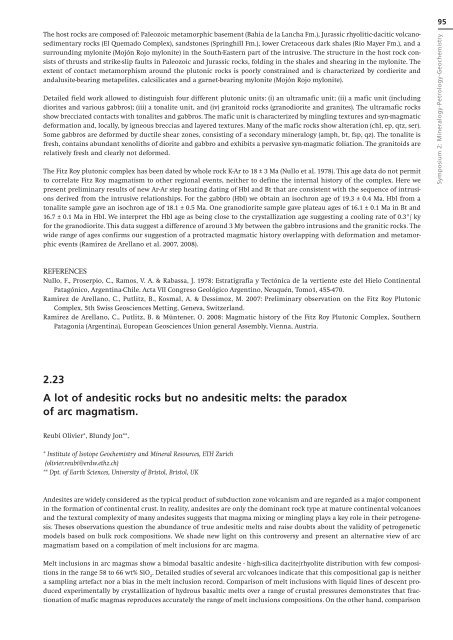Open Session - SWISS GEOSCIENCE MEETINGs
Open Session - SWISS GEOSCIENCE MEETINGs
Open Session - SWISS GEOSCIENCE MEETINGs
You also want an ePaper? Increase the reach of your titles
YUMPU automatically turns print PDFs into web optimized ePapers that Google loves.
The host rocks are composed of: Paleozoic metamorphic basement (Bahia de la Lancha Fm.), Jurassic rhyolitic-dacitic volcanosedimentary<br />
rocks (El Quemado Complex), sandstones (Springhill Fm.), lower Cretaceous dark shales (Rio Mayer Fm.), and a<br />
surrounding mylonite (Mojón Rojo mylonite) in the South-Eastern part of the intrusive. The structure in the host rock consists<br />
of thrusts and strike-slip faults in Paleozoic and Jurassic rocks, folding in the shales and shearing in the mylonite. The<br />
extent of contact metamorphism around the plutonic rocks is poorly constrained and is characterized by cordierite and<br />
andalusite-bearing metapelites, calcsilicates and a garnet-bearing mylonite (Mojón Rojo mylonite).<br />
Detailed field work allowed to distinguish four different plutonic units: (i) an ultramafic unit; (ii) a mafic unit (including<br />
diorites and various gabbros); (iii) a tonalite unit, and (iv) granitoid rocks (granodiorite and granites). The ultramafic rocks<br />
show brecciated contacts with tonalites and gabbros. The mafic unit is characterized by mingling textures and syn-magmatic<br />
deformation and, locally, by igneous breccias and layered textures. Many of the mafic rocks show alteration (chl, ep, qtz, ser).<br />
Some gabbros are deformed by ductile shear zones, consisting of a secondary mineralogy (amph, bt, fsp, qz). The tonalite is<br />
fresh, contains abundant xenoliths of diorite and gabbro and exhibits a pervasive syn-magmatic foliation. The granitoids are<br />
relatively fresh and clearly not deformed.<br />
The Fitz Roy plutonic complex has been dated by whole rock K-Ar to 18 ± 3 Ma (Nullo et al. 1978). This age data do not permit<br />
to correlate Fitz Roy magmatism to other regional events, neither to define the internal history of the complex. Here we<br />
present preliminary results of new Ar-Ar step heating dating of Hbl and Bt that are consistent with the sequence of intrusions<br />
derived from the intrusive relationships. For the gabbro (Hbl) we obtain an isochron age of 19.3 ± 0.4 Ma. Hbl from a<br />
tonalite sample gave an isochron age of 18.1 ± 0.5 Ma. One granodiorite sample gave plateau ages of 16.1 ± 0.1 Ma in Bt and<br />
16.7 ± 0.1 Ma in Hbl. We interpret the Hbl age as being close to the crystallization age suggesting a cooling rate of 0.3°/ ky<br />
for the granodiorite. This data suggest a difference of around 3 My between the gabbro intrusions and the granitic rocks. The<br />
wide range of ages confirms our suggestion of a protracted magmatic history overlapping with deformation and metamorphic<br />
events (Ramírez de Arellano et al. 2007, 2008).<br />
REFERENCES<br />
Nullo, F., Proserpio, C., Ramos, V. A. & Rabassa, J. 1978: Estratigrafía y Tectónica de la vertiente este del Hielo Continental<br />
Patagónico, Argentina-Chile. Acta VII Congreso Geológico Argentino, Neuquén, Tomo1, 455-470.<br />
Ramírez de Arellano, C., Putlitz, B., Kosmal, A. & Dessimoz, M. 2007: Preliminary observation on the Fitz Roy Plutonic<br />
Complex, 5th Swiss Geosciences Metting, Geneva, Switzerland.<br />
Ramírez de Arellano, C., Putlitz, B. & Müntener, O. 2008: Magmatic history of the Fitz Roy Plutonic Complex, Southern<br />
Patagonia (Argentina), European Geosciences Union general Assembly, Vienna, Austria.<br />
2.23<br />
A lot of andesitic rocks but no andesitic melts: the paradox<br />
of arc magmatism.<br />
Reubi Olivier*, Blundy Jon**,<br />
* Institute of Isotope Geochemistry and Mineral Resources, ETH Zurich<br />
(olivier.reubi@erdw.ethz.ch)<br />
** Dpt. of Earth Sciences, University of Bristol, Bristol, UK<br />
Andesites are widely considered as the typical product of subduction zone volcanism and are regarded as a major component<br />
in the formation of continental crust. In reality, andesites are only the dominant rock type at mature continental volcanoes<br />
and the textural complexity of many andesites suggests that magma mixing or mingling plays a key role in their petrogenesis.<br />
Theses observations question the abundance of true andesitic melts and raise doubts about the validity of petrogenetic<br />
models based on bulk rock compositions. We shade new light on this controversy and present an alternative view of arc<br />
magmatism based on a compilation of melt inclusions for arc magma.<br />
Melt inclusions in arc magmas show a bimodal basaltic andesite - high-silica dacite/rhyolite distribution with few compositions<br />
in the range 58 to 66 wt% SiO 2 . Detailed studies of several arc volcanoes indicate that this compositional gap is neither<br />
a sampling artefact nor a bias in the melt inclusion record. Comparison of melt inclusions with liquid lines of descent produced<br />
experimentally by crystallization of hydrous basaltic melts over a range of crustal pressures demonstrates that fractionation<br />
of mafic magmas reproduces accurately the range of melt inclusions compositions. On the other hand, comparison<br />
Symposium 2: Mineralogy-Petrology-Geochemistry









